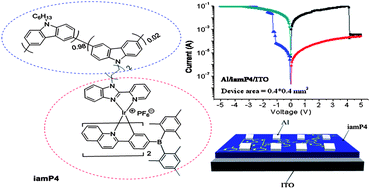Polycarbazole and polyfluorene containing cationic iridium(III) complexes in the side-chain have been designed and synthesized. Both polymers have been demonstrated to show conductance switching behavior and non-volatile flash memory devices based on them were successfully realized, in which the formation and dissociation of through-space charge-transfer states from the conjugated polymer “sea” to the Ir(III) complex “island”, controlled by voltage, are responsible for the conductance switching behavior and memory effect. The devices exhibit low reading, writing, and erasing voltages and a high ON/OFF current ratio. Both ON and OFF states are stable up to 107 read cycles at a read voltage of −1.0 V. Due to the different chemical structures of the polymer main-chain, the two devices show different threshold voltages. The polycarbazole derivative exhibits higher HOMO and LUMO levels compared with the polyfluorene analogue. Thus, the threshold voltage from the OFF to ON state of the device based on the polycarbazole derivative is obviously lower than that of the polyfluorene derivative-based device because of the low energy barrier between the work function of the ITO anode and the HOMO level of the polycarbazole derivative. Similarly, the threshold voltage from the ON to OFF state is evidently higher because the energy barrier of electron injection from Al into the LUMO of the polycarbazole derivative is slightly higher than that of the polyfluorene analogue. Thus, the threshold voltages of memory devices may be rationally modulated by modifying the chemical structure of polymers.

You have access to this article
 Please wait while we load your content...
Something went wrong. Try again?
Please wait while we load your content...
Something went wrong. Try again?


 Please wait while we load your content...
Please wait while we load your content...